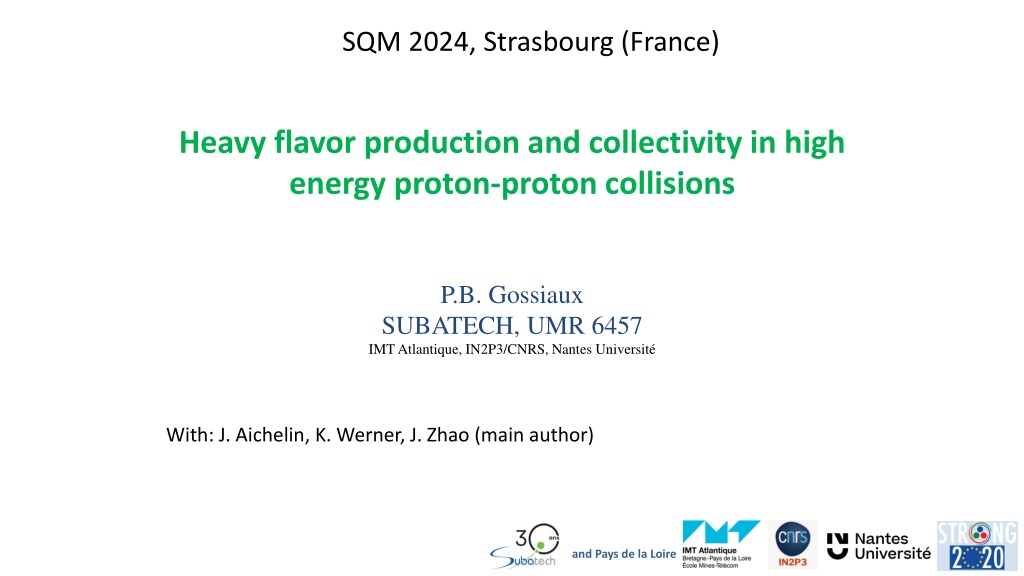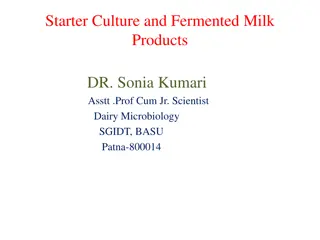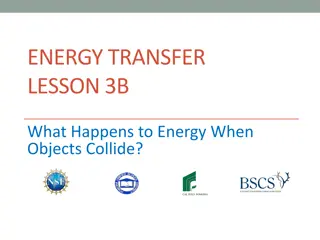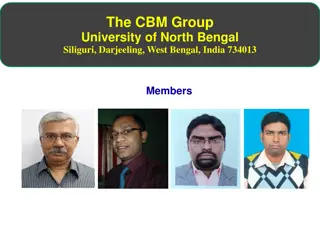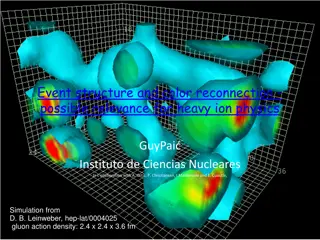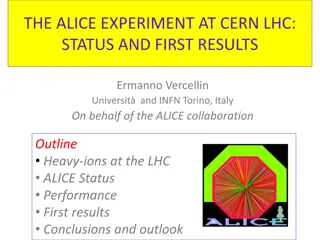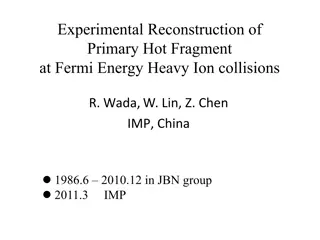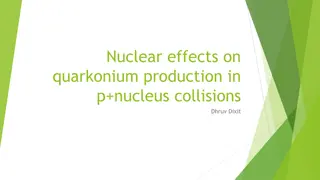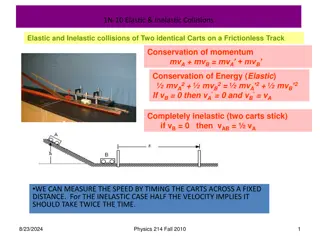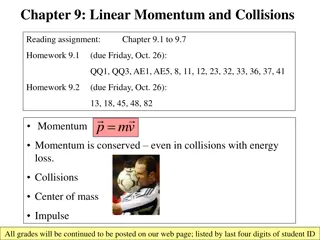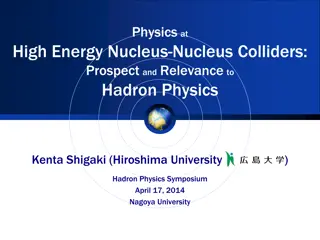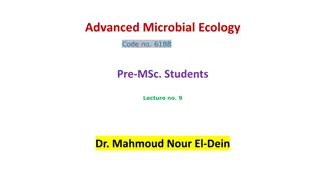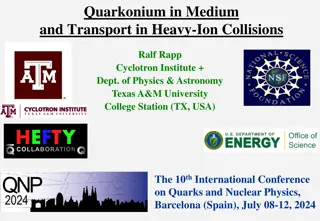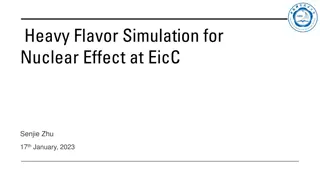Exploring Heavy Flavor Production in High-Energy Collisions
Studying heavy flavor production and collectivity in proton-proton collisions at high energies, this research delves into the effects of collectivity in large and small systems through EPOS4-HQ modeling. It investigates energy loss, coupling with QGP, collectivity, and more, utilizing the EPOS framework encompassing various collision scenarios. The study also examines initial conditions, core-corona dynamics, and the interaction of EPOS with VHHLE hydro as a background for HQ studies.
Download Presentation

Please find below an Image/Link to download the presentation.
The content on the website is provided AS IS for your information and personal use only. It may not be sold, licensed, or shared on other websites without obtaining consent from the author. Download presentation by click this link. If you encounter any issues during the download, it is possible that the publisher has removed the file from their server.
E N D
Presentation Transcript
SQM 2024, Strasbourg (France) Heavy flavor production and collectivity in high energy proton-proton collisions P.B. Gossiaux SUBATECH, UMR 6457 IMT Atlantique, IN2P3/CNRS, Nantes Universit With: J. Aichelin, K. Werner, J. Zhao (main author) and Pays de la Loire
HF Borromeos rings of collectivity Motivation: Studying the collectivity effects in large and small systems as modeled by EPOS4-HQ HF production and correlations Energy loss and coupling with QGP Collectivity Open Heavy Flavors and Quarkonia Hadronization 2
EPOS initial conditions EPOS + Hydro : state of the art framework that encompass pp, pA and AA collisions Incoming nucleons EPOS (initial conditions): Model based on Gribov-Regge multiple pomeron interactions Particle production (including HQ, from EPOS 3 on) in cut (semi-hard) pomerons, seen as partons ladder Space like DGLAP evolution with hard Born process Soft particles form a flux tube (string, with its own dynamics, incl. string breaking) lots of them in A-A Slow string segments (pre-hadrons), far from the surface, are mapped to fluid dynamic fields Hard particles (kinky string) -> jets SLC Born Kinky string jet Ref: K. Werner, Iu. Karpenko, M. Bleicher, T. Pierog, and S. Porteboeuf-Houssais Phys. Rev. C 85 (2012), 064907 + many refs in 2023 (https://klaus.pages.in2p3.fr/epos4/ ) 3
EPOS initial conditions Simple but efficient initial-stage in EPOS : Core-Corona picture If the energy loss is bigger than the energy of the prehadron, it is considered to be part of the core If the energy loss is smaller than the energy, the prehadron escapes, it is called corona Core: hydrodynamics; Corona: hadronic phase The energy density is larger than the critical energy density 0 > deconfined QCD matter and hydro evolution 4
EPOS + VHHLE hydro as a background for HQ EPOS: state of the art framework that encompass pp, pA and AA collisions Initial energy density Beware: color scales EPOS Pb-Pb peripheral EPOS Pb-Pb central More realistic hydro and initial conditions => original HQ studies such as: 1) fluctuations in HQ observables 2) correlations between HF and light hadrons 5
1 year ago: EPOS4 https://klaus.pages.in2p3.fr/epos4/ 6
One Novelty in EPOS4: Curing the factorization issue K. Werner. arXiv: 2301.12517 pomeron Double scattering diagram // energy conservation Rdeform: Depletion of the high pomeron mass frequency due to many energy sharings Invariant mass of the hard pomeron is reduced due to the connection of both projectile and target pomerons to other pomerons 7
One Novelty in EPOS4: Curing the factorization issue Rdeform: Depletion of the high pomeron mass frequency due to many energy sharings The cut pomeron The amazingly simple solution in EPOS4: define With Qsat(Nconn,x+,x-) chosen implicitly such that G does not depend on Nconn. which perfectly warrant the factorization at large pT; one recovers binary scaling (generalized Abramovskii Gribov Kancheli theorem). For large Nconn, low pTis suppressed 8
One Novelty in EPOS4: Curing the factorization issue Rdeform: Depletion of the high pomeron mass frequency due to many energy sharings The cut pomeron The amazingly simple solution in EPOS4: define With Qsat(Nconn,x+,x-) chosen implicitly such that G does not depend on Nconn. which perfectly warrant the factorization at large pT; one recovers binary scaling (generalized Abramovskii Gribov Kancheli theorem). For large Nconn, low pTis suppressed 9
EPOS4 for small systems EPOS + Hydro : state of the art framework that encompass pp, pA and AA collisions => Go and look in pp The energy density is larger than the critical energy density 0 > deconfined QCD matter in pp as well ! => In EPOS4, QGP droplet is one of the ingredients of collectivity 10
Full EPOS4: checking multiplicity dependencies and <pt> continuous curve jump Affected by: core-corona microcanonical hadronic cascade (UrQMD) Saturation Flow core-corona 11
HQ sector: Improved HF production in EPOS4 Initial production of heavy quarks through K. Werner, B. Guiot, Phys.Rev.C 108 (2023) 3, 034904 Found in the following evolutions : Includes the 3 basic mechanisms present in other MC generator like Pythia Gluon splitting Flavor excitation Flavor creation (LO) Later hadronized through string breaking in EPOS4 Born TLC SLC 12
From EPOS4 to (MC@s)HQ QGP Bulk (t) + initial distribution of HQ EPOS HQ 13
The core energy loss from the HQ part Colisional component One-gluon exchange model: reduced IR regulator m2Dself in the hard propagator, fixed on HTL Energy loss (maximal insensitivity of dE/dx on q*) Running coupling eff (t) self consistent Debye mass mDself2(T) = (1+nf/6) 4 eff(mDself2)T2 + u and s channels D: drag coefficient Recent lQCD data Comparison with Peign -Peshier at finite momentum 14
The core energy loss from the HQ part Radiative component + + + Extension of Gunion-Bertsch approximation beyond mid-rapidity and to finite mass mQ) distribution of induced gluon radiation per collision ( rad E L): LPM effect for moderate gluon energy Implemented in EPOS4-HQ through Boltzmann transport 15
Heavy quarks (Q) as ideal hard probes: Evolution in the QGP DOES NOT modify the yield of initial Q and Qbar: Negligible annihilation rate ! Heavy flavor It only impacts their distribution in momentum o Hence, for usual observables like RAA and v2 only the initial 1 body distribution matters Mostly like in elementary pp collisions Weak decays However hadronization is affected by the QGP o Other mechanism wrt usual fragmentation of HQ in elementary collisions : coalescence / recombination Interaction w. hadrons Hadronization Interaction w. QGP Interaction w. glasma & B Hard production (mc>> QCD) The recombination of heavy quark with some existing light quark(s) from the QGP is an essential mechanism at low pT< 5-10 GeV/c Mandatory to understand the c/D0ratio 16
The coalescence + fragmentation hadronization J. Zhao s work 17
HF in EPOS4-HQ Open HF in AA EPOS4-HQ Quarkonia in AA Open HF in pp Quarkonia in pp 18
OHF hadrons pTdistributions in EPOS4-HQ PbPb central @ LHC Very good agreement for all resonances 19
OHF hadrons pTdistributions in EPOS4-HQ PbPb central @ LHC Largest effect in AA : Energy loss of c-quarks 20
HF in EPOS4-HQ Open HF in AA Quarkonia in AA Open HF in pp EPOS4-HQ Quarkonia in pp 21
HF production in pp See K. Werner. arXiv: 2306.02396 Some overshooting of the FONLL uncertainty band below 1 GeV, but very good agreement at large pT where FONLL is best justified Dominance of the flavor excitation mechanism at small pt 22
Hadrons yield in pp Good agreement in the pp sector, essentially due to the coalescence + fragmentation hadronization 23
Yield ratios in pp The coalescence + fragmentation hadronization is also successful in describing the yield ratio between charmed baryon to meson ! See as well : M. He and R. Rapp, Phys. Lett. B 795, 117 (2019), V. Minissale, S. Plumari, and V. Greco, Phys. Lett. B 821, 136622 (2021), H.-h. Li, F.-l. Shao, and J. Song, Chin. Phys. C 45, 113105 (2021), A. Beraudo, A. De Pace, D. Pablos, F. Prino, M. Monteno, and M. Nardi, arXiv:2306.02152 24
QGP droplet in pp ? The yield ratio increase with centrality is correlated with the fraction of c quarks which interact with the QGP droplet 25
Azimuthal distributions in pp: v2 EPOS4HQ describes well the elliptic flow of D meson ! Clear sign of momentum redistribution during the short evolution (only comes through the v2in pp) Little effect of the hadronic stage See as well : A. Beraudo, A. De Pace, D. Pablos, F. Prino, M. Monteno, and M. Nardi, arXiv:2306.02152 26
Azimuthal distributions in pp: v2 EPOS4HQ describes well the elliptic flow of D meson ! Clear sign of momentum redistribution during the short evolution (only comes through the v2in pp) Little effect of the hadronic stage See as well : A. Beraudo, A. De Pace, D. Pablos, F. Prino, M. Monteno, and M. Nardi, arXiv:2306.02152 27
Azimuthal distributions in pp Small modification to the azimuthal correlations => constrain the HQ production process via final ? ? correlations! Good agreement with the experiment (also for other correlations) 28
Recap : HF in pp Coalescence in the presence of a QGP droplet LARGE effect observable HQ energy loss in QGP Hadron pt spectra Little effect Hadron yield ratios Little effect LARGE effect v2 Little effect LARGE effect Azimuthal correlations Little effect Little effect According to EPOS4-HQ: Everything consistent with the production of a short- lived QGP in most active pp collisions at LHC To come : adding the quarkonia component 29
HF Borromeos rings HF production and correlations Energy loss and coupling with QGP Open Heavy Flavors and Quarkonia Hadronization Crucial to consider all facets of the problem, as in the new EPOS4-HQ framework 30
Back up 3 1
Elliptic flow in EPOS4-HQ PbPb @ LHC Good agreement with data, maybe some excess at large pT(one should investigate path length anisotropy in the bulk) Most of the v2generated by the interaction of the c- quarks with the QGP
Hadronization of heavy quarks Recent effort of theorists to compare their hadronization schemes at the end of the QGP Jiaxing Zhao et al., 2311.10621 dND/dpTof the direct D0meson produced by a c-quark with pT= 3 GeV and 10 GeV Mixed Fragmentation- Recombination Pure Recombination Diversity => things to learn ! Hadrochemistry of Heavy Flavor will be a major subject of investigation for ALICE 3. But also in small systems like pp (many signs of collectivity in small systems => QGP ?)
2023: Bundle 4: EPOS4-HQ Ingredient B1 B2 (MC@sHQ+EPOS2) B4 (EPOS4-HQ) hydro Kolb Heinz vHLLE (0 viscosity) Viscous vHLLE B 1 Init cond (soft) Glauber EPOS EPOS4 Init state fluctuations No Yes Yes hadronization Covar. Inst. Coal + frag Same New scheme HQ production FONLL (p) + Glauber (space) FONLL (p) + EPOS (space): position of NN interactions EPOS4 CNM No shadowing, initial kT broad. EPS09 EPOS4 Hadronic interaction None None URQMD Still no modification of the ELOSS model maybe as an outcome of the comparison In the following results : elastic + radiative
OHF hadrons pTdistributions in EPOS4-HQ Yield ratios in PbPb @ LHC Experimental trends well reproduced Need for more precise data to improve the hadronization chemistry
hadrons pTdistributions in EPOS4-HQ PbPb semi-central @ LHC Very good agreement for all resonances
hadrons pTdistributions in EPOS4-HQ AuAu central @ RHIC Very good agreement for all resonances
hadrons pTdistributions in EPOS4-HQ Very good agreement for all resonances
Elliptic flow in EPOS4-HQ AuAu @ RHIC Slight underestimation around 3 GeV/c probably need sPHENIX data before concluding
